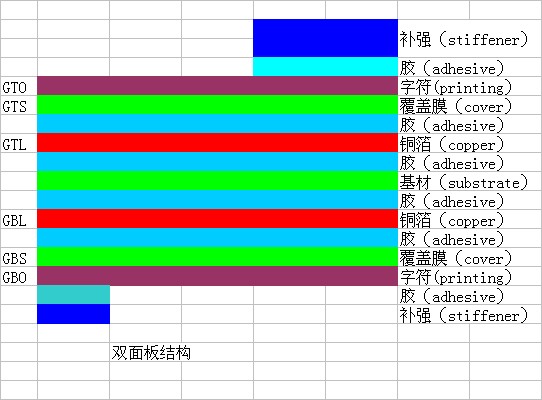Flexible PCB Glossary
Here is a simple stackup for 2 layer FPC. With this FPC stackup,we can understand easily for the Flex PCB glossary.

Coverlay
Special material used to insulate the outer surface conductors of a flexible PCB region. Protects against corrosion and damage, similar to how solder mask is used on rigid sections. Polyimide and Polyester are two common materials used as coverlay.
Substrate
Base dielectric material used in PCBs. Flex circuits are simply manufactured using Polyimide or Polyester films as substrate material, while cured epoxy is added in rigid sections to stiffen the board area.
Polyimide (PI)
Material commonly used for substrate and coverlay films in flex circuits. It can support high-temperature processes such as soldering and wire bonding,making it ideal for most applications. It is higher cost than other standard films such as Polyester.
Polyester (PET)
Material commonly used for substrate and coverlay films in flex circuits. It is not tolerant of high temperatures, but is more dimensionally stable than Polyimide. Typically, PET film is used in low-cost electronics where no soldering process is necessary, but strong mechanical performance is required at room temperature.
Electro-Deposited (ED)
Copper foil traditionally used with standard rigid PCBs. One of the most cost effective conductor options, but generally not suitable for flex applications.
Rolled Annealed (RA)
Copper foil used for dynamic flex purposes, offering more durability and endurance. Electro-deposited copper foil is passed through high-pressure rollers, elongating the grain structure in a planar orientation, and making the copper more flexible and springy.
Adhesive
Material used to bond copper foil to substrate and coverlay films on flex circuits. In rigid boards, heat and pressure are adequate for creating a reliable bond, without the use of adhesive. Rolled annealed copper foil, used with flex circuits, has less “tooth” than electro-deposited, and does require the use of adhesive.Acrylic and epoxy resins are two common types of adhesive.
Adhesive Beads
Strengthener used where a flex circuit exits the rigid board. Automatic fluid dispensing can be used to apply beads of acrylic or epoxy resin, but caution must be taken to prevent excess glue from dripping under the assembly. Often,application must be done by hand.
Stiffener
Extra material, usually thick Polyimide or FR-4, added to the extreme end of aflex circuit. Stiffeners are applied to enhance durability at the termination of a flex circuit to a connector or main rigid board.
Cavity
Chamber created internally in a PCB to allow clearance for an Embedded Component body.
High-Density Interconnection (HDI)
Collection of design methods used to significantly increase routing density.There are unique challenges presented when designing HDI or Ultra HDI flex circuits.